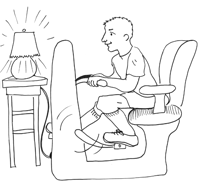STRANGE BUT TRUE- China syndrome: Peddling can't beat one-kid policy

DRAWING BY DEBORAH DERR McCLINTOCK
Q. Sometimes even everyday eco-dilemmas can raise pretty offbeat questions, like "Why can't the machines in my gym be used to generate electricity?" or "Can I save the planet by staying slim?" or "What's the single most effective thing I can do for the environment?" –P. Wendel
A. Answer #1: The Green Microgym in Portland, Oregon, converts the efforts of gym bunnies using specially adapted bikes which combine cycles and hand cranks to generate up to 1,000 watts, says New Scientist magazine.
You can do this at home with a Pedal-A-Watt that when hooked up to a normal bicycle on a stand allows a cyclist to generate up to 200 watts of electricity– enough to power a large TV. Or if directed into a battery, an hour's cycling could run a low-energy light bulb for eight hours.
Answer #2: Not likely, though two writers argued in The Lancet that the obese consume around 18 percent more calories than average, and that their greater mass means more auto fuel burned. So policies to encourage walking and cycling would not only improve people's health but also be good for Planet Earth.
Still, those are short-term benefits and more than offset by the added longevity of those who, staying in shape, emit tons of carbon dioxide for every extra year they live.
Answer #3: Draconian as this may sound, the single most effective thing you can do for the planet is to refrain from having children. Over a 75-year lifespan, the average European will be responsible for about 900 tons of carbon dioxide emissions, 1,500 tons for an American!
Q. What's the classic tip about "degraded surroundings" that we should all keep in mind regarding our own neighborhoods? –J. Tolbert
A. That degraded surroundings all too easily lead to degraded behavior, called the "broken window effect," says Constance Holden in Science magazine. Disorder in the environment has a generalized effect where people who see one norm being broken become more likely to violate other norms. So all it takes is graffiti on building walls or trash on the sidewalk, fliers littering the street or firecrackers being set off to trigger illegal parking of vehicles, mail theft or worse.
The flip side– and the hope for humankind– is that pro-social acts are contagious as well: Social psychologist Robert Cialdini suggests that because of this, government agencies can expect a big payoff for relatively minor efforts such as keeping the streets clean.
Moral: Do good, and you can more justifiably expect good to come back to you and your neighbors.
Q. Take a U.S. $20 bill and look at the "20" in the front lower right corner. What color is it, and how does this change when you tilt the bill and look at the number obliquely? What's behind this "colorful" subtlety? –A. Jackson
A. Such a variable tint results from color-shifting inks, designed to thwart counterfeiters who use copy machines to make passable replicas of certain bills, says Jearl Walker in The Flying Circus of Physics.
A copier can duplicate color from only one perspective and so cannot duplicate the subtle color-shifting in a genuine bill where the "20" first appears red or red-yellow, then green when viewed obliquely. Governments worldwide scurry to stay ahead of counterfeiters who use the latest technology to duplicate paper currencies. Other anti-counterfeiting measures are security threads and special water marks (both visible if the currency is held up to the light) and microprinting (consisting of dots too small to be reproduced by a scanner).
Q. An energy guzzler's puzzler: Suppose we had a 100-year supply (100 units) of petroleum at our current rate of consumption, and we couldn't find any more. If we reduced our annual use by just one percent each year, now how long would the supply last? a) about 150 years b) 300 years c) 700 years d) forever –P. Faisal
A. Use would go like this: one unit (a current year's worth) of oil the first year, then .99 units the second year, then .99 x .99 units (or .9801 units) the third year, etc. At this rate, in the 10th year we'd consume .914 units, and our total use for the 10 years would be about 9.6 units (out of the 100 units total supply). Over the next 10 years we'd go through only 8.6 more units, for a total of about 18.2 units over the 20 years.
If you continued to crunch these numbers, you'd see an amazing thing: By the 700th year we'd have only about 0.1 units left (one-thousandth of the original 100-unit supply), but we'd be consuming at the rate of only 0.001 units per year. So a 100-year supply of oil would still remain at the consumption rate for that year!
This can go on forever at the one percent reduction per year, so the answer is d), we'd never run out.
Could people in 2700 A.D. get by on such a tiny usage of petroleum? You'd probably be amazed at what they could do. What would someone from 1300 A.D. think of cell phones, computers, and microwave ovens?
~
Send Strange questions to brothers Bill and Rich at [email protected].
#